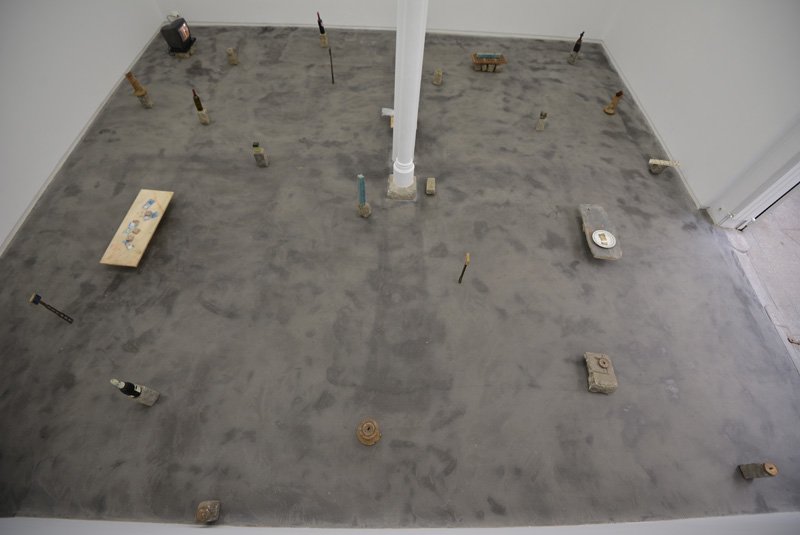
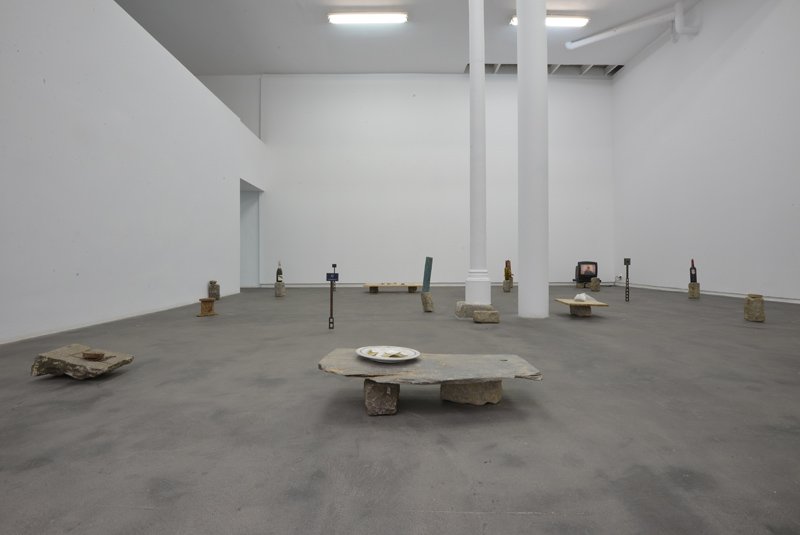
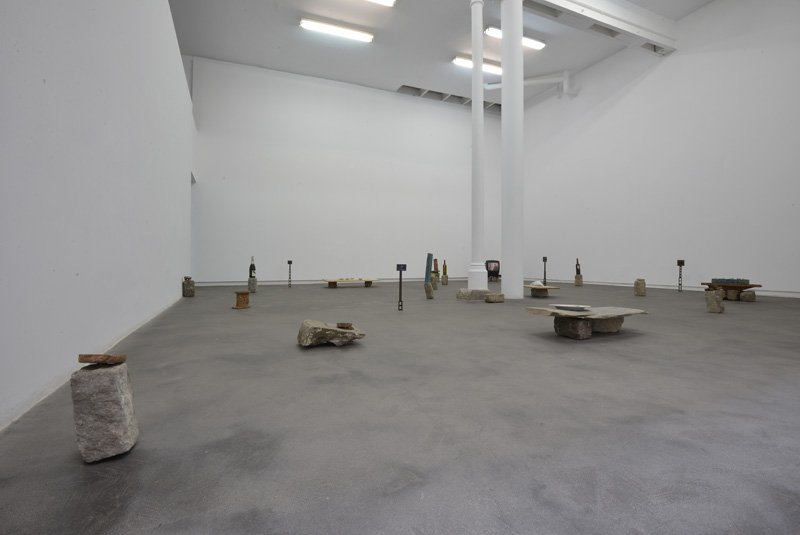

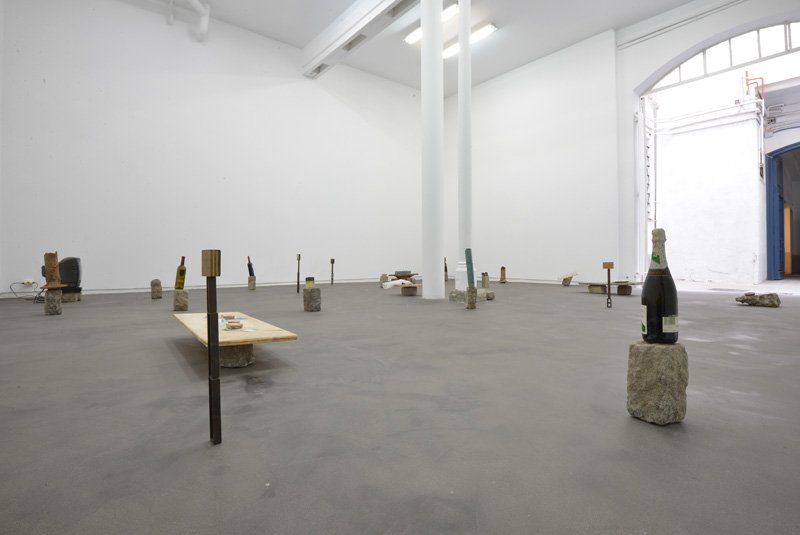
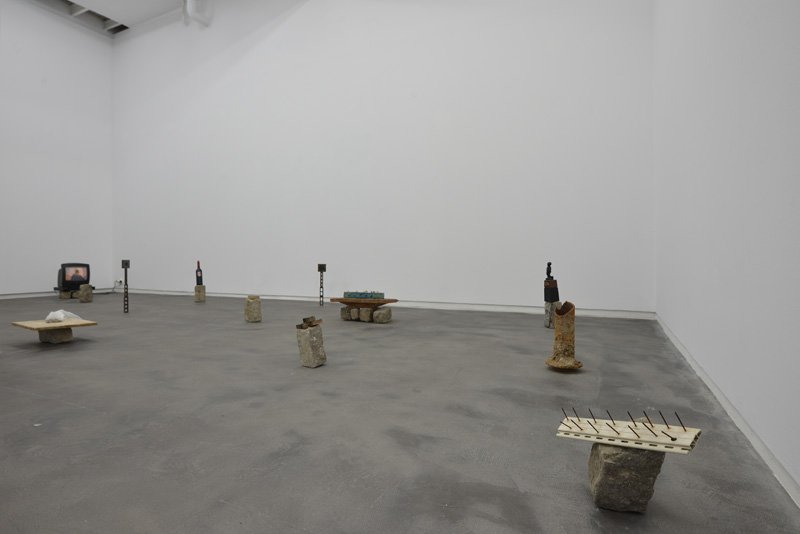
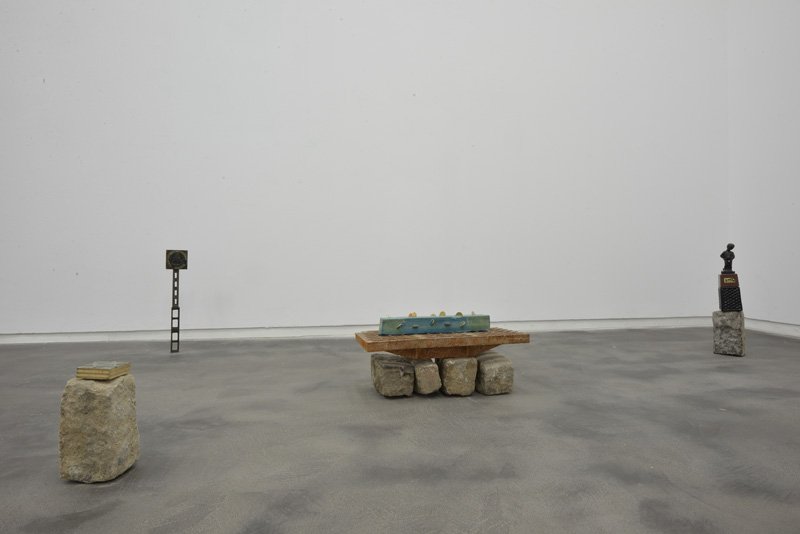
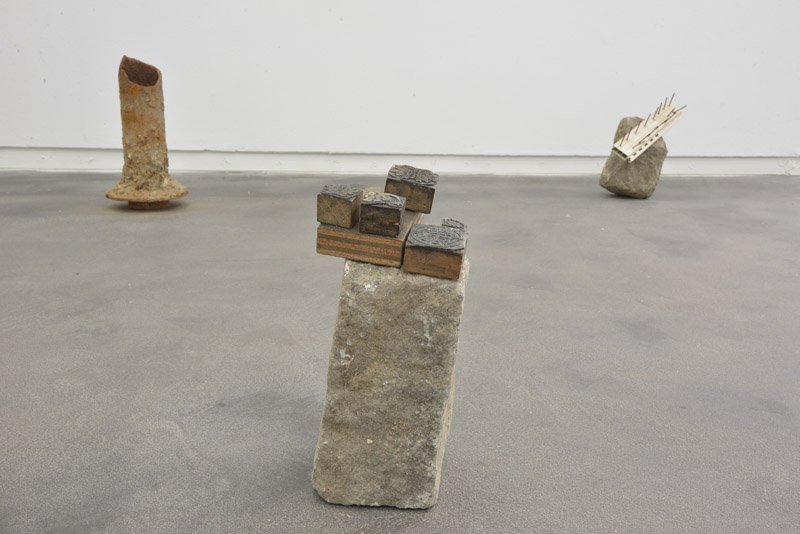
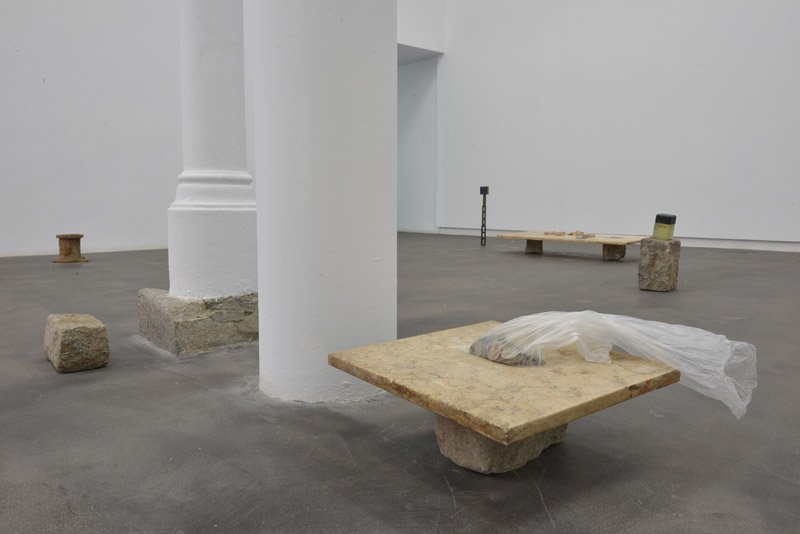
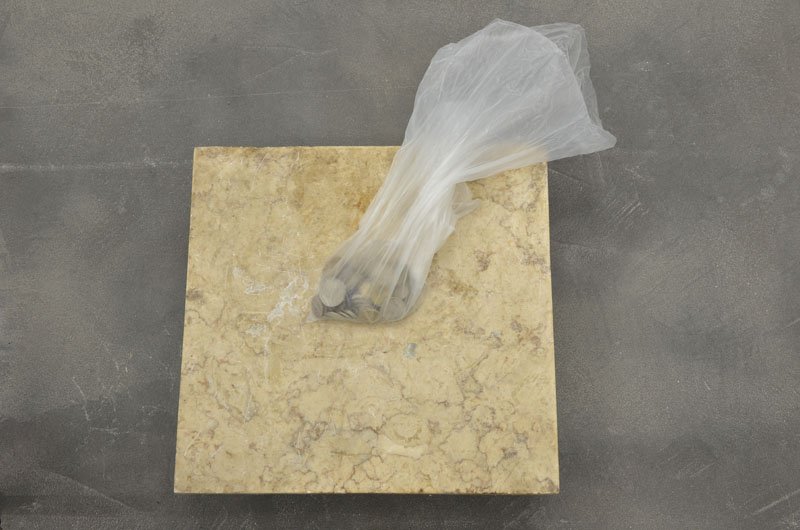
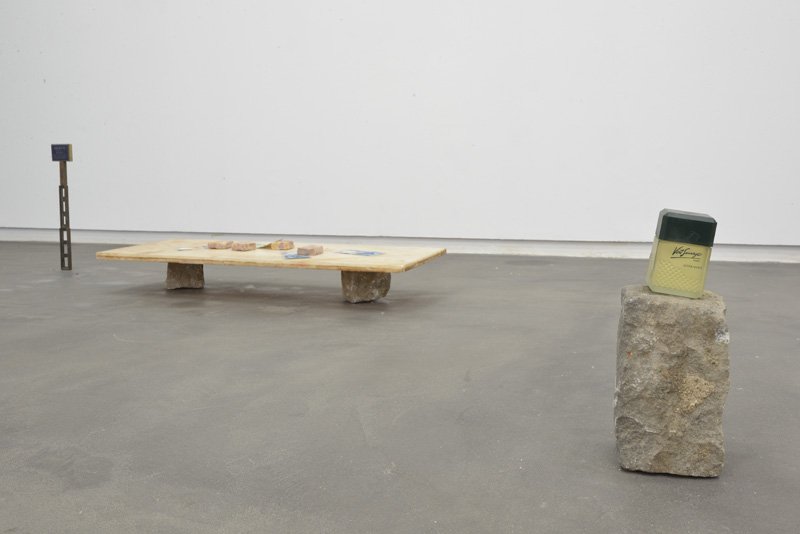
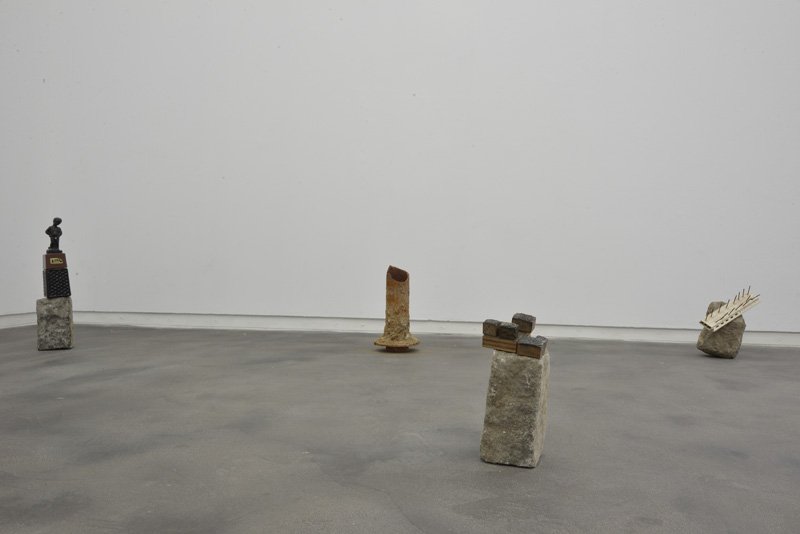

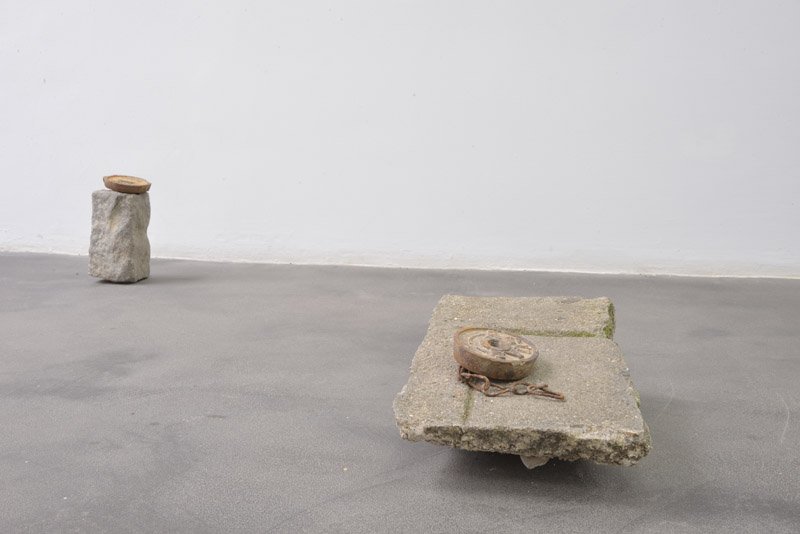
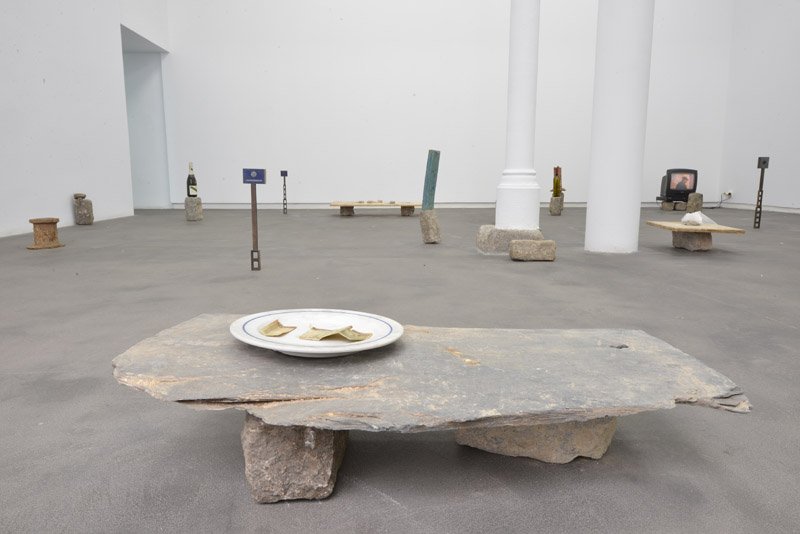

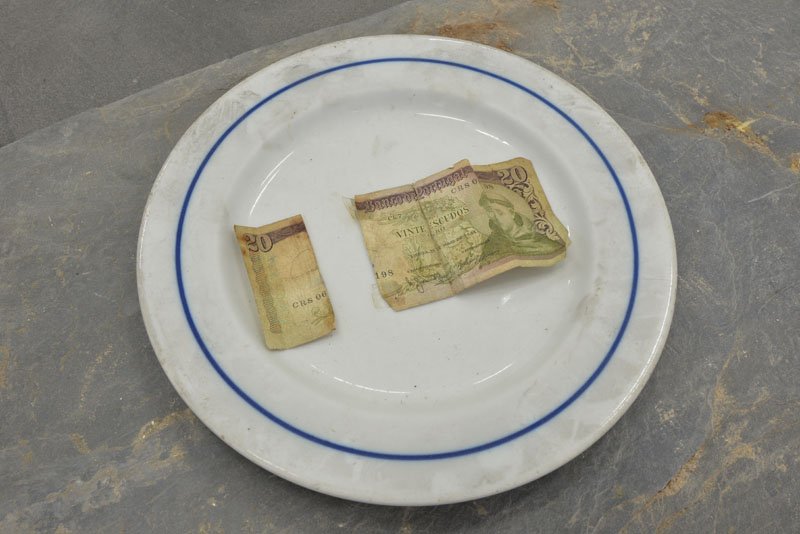
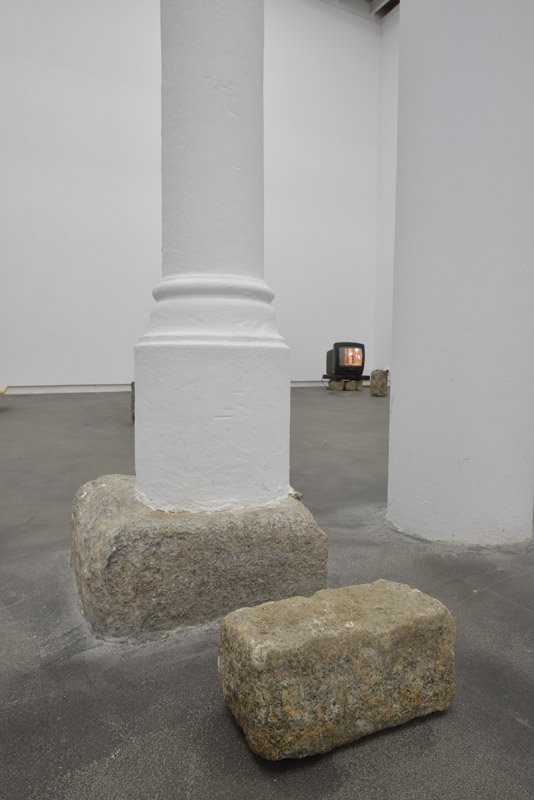
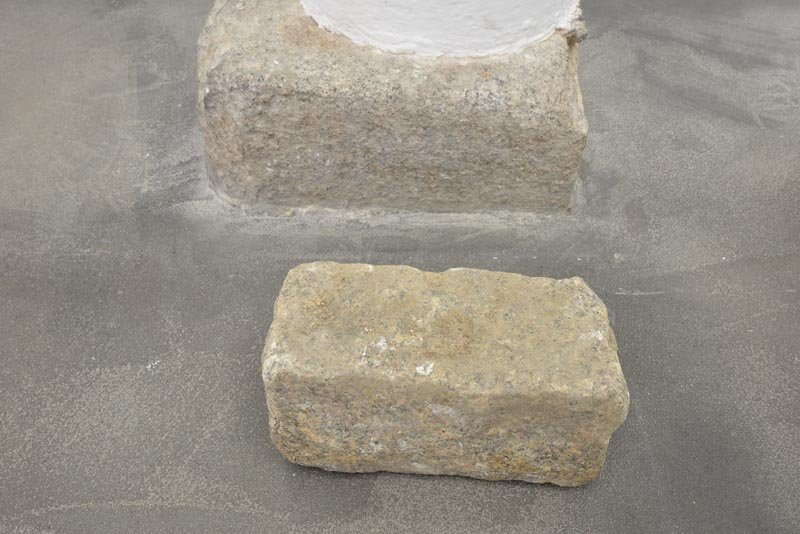
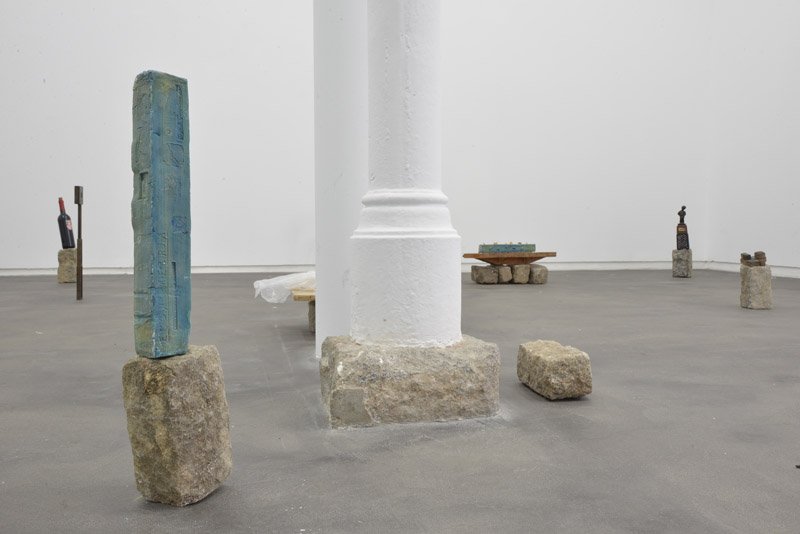
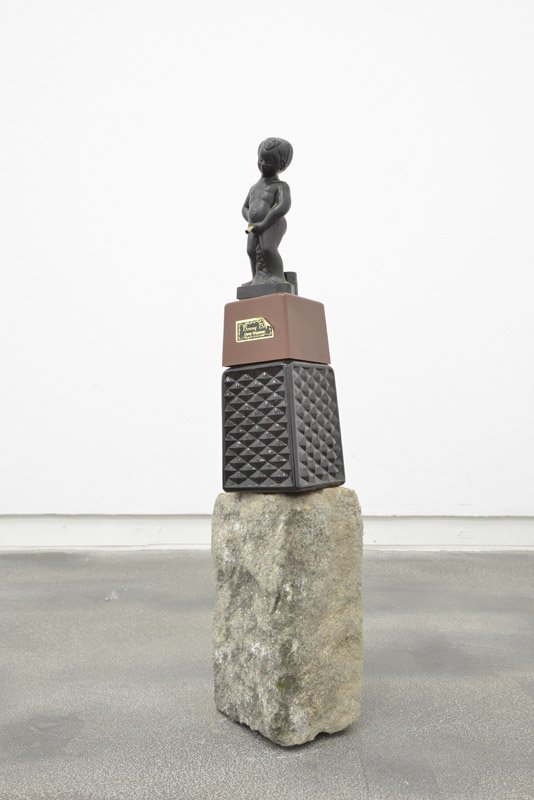


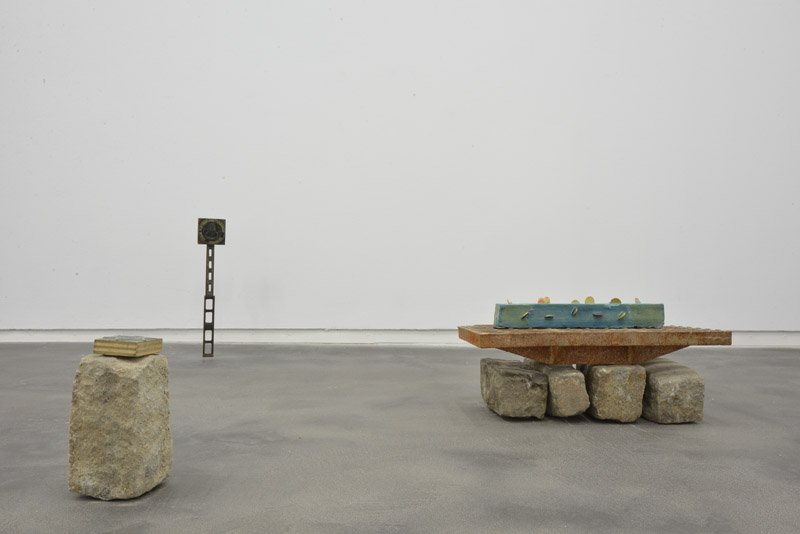
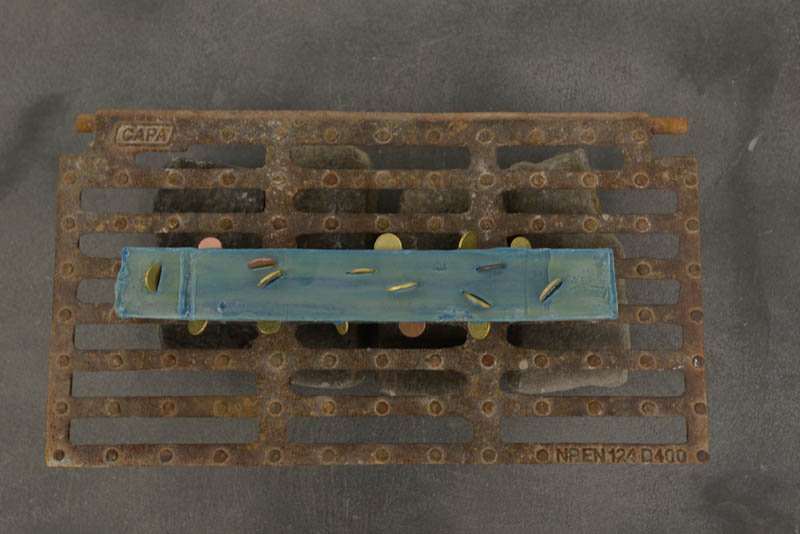
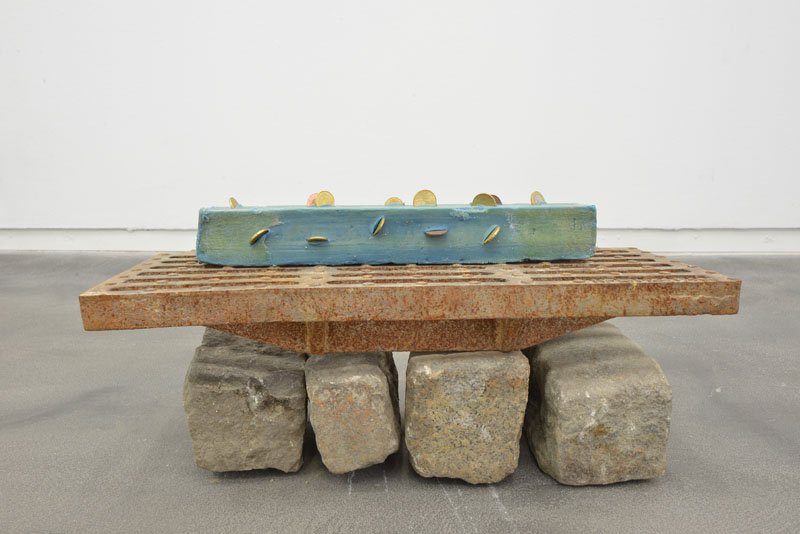

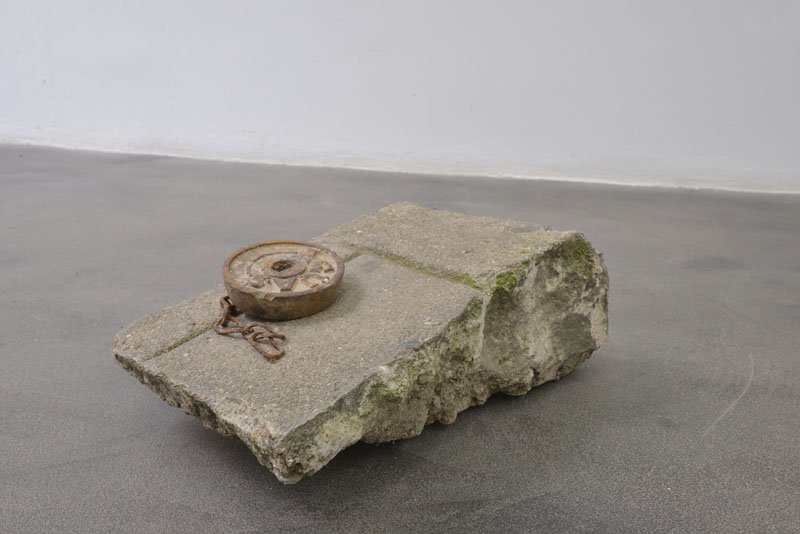
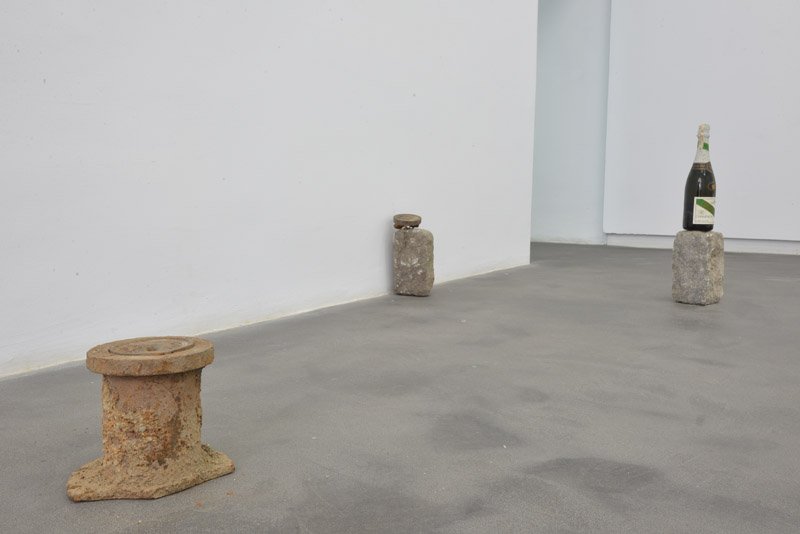
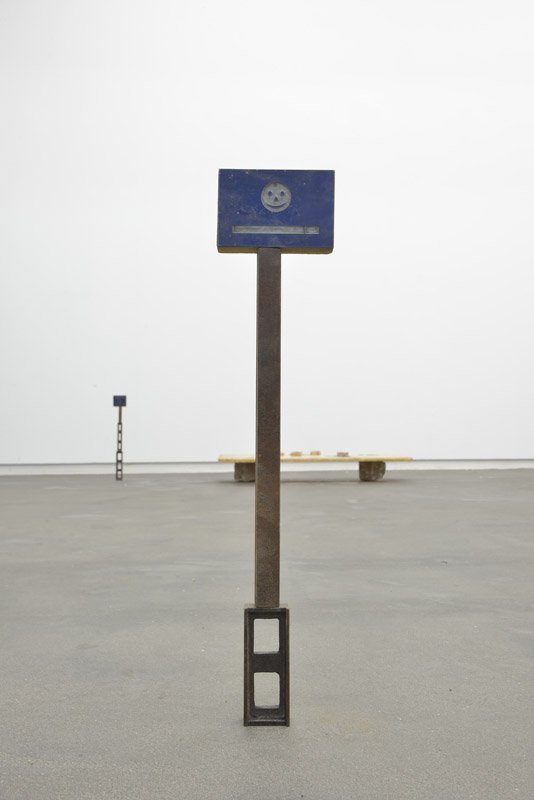
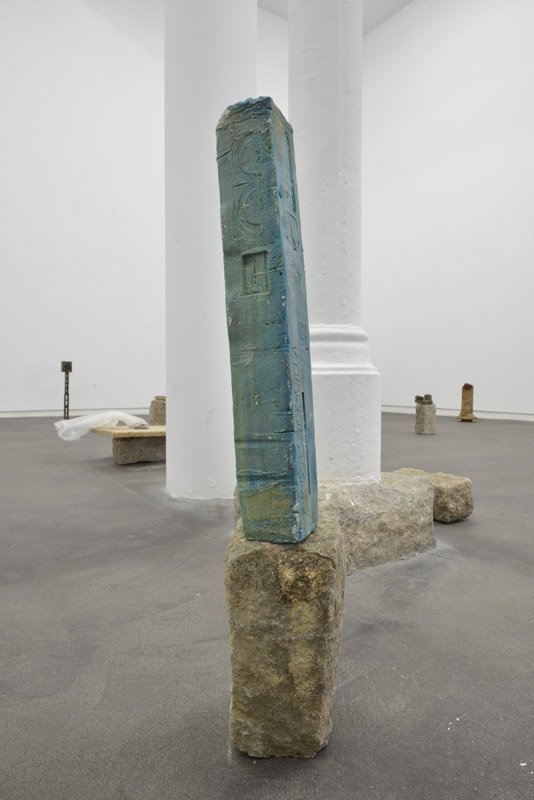
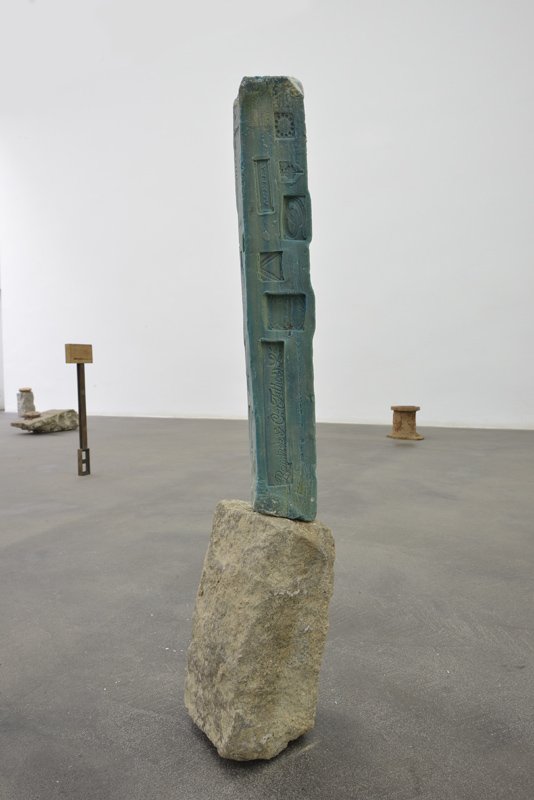
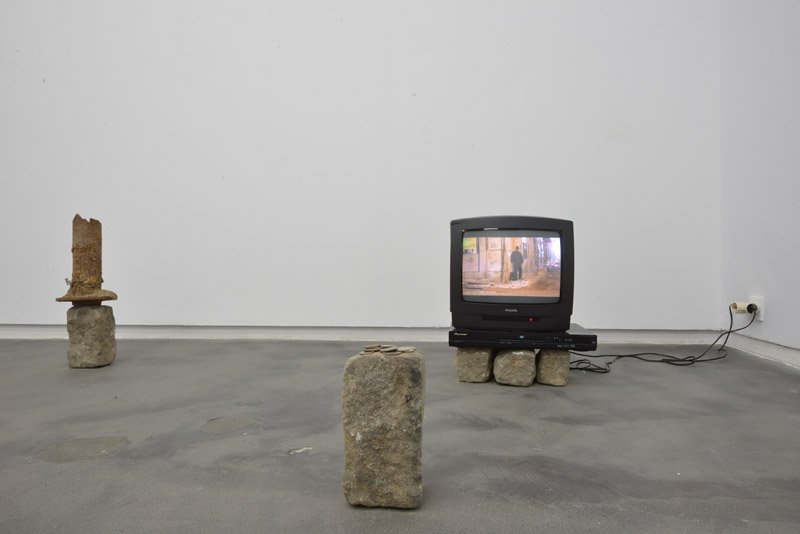
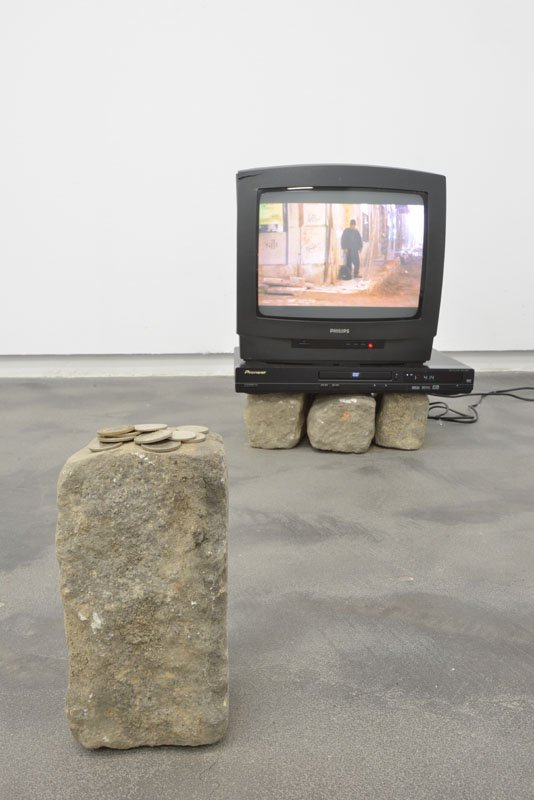
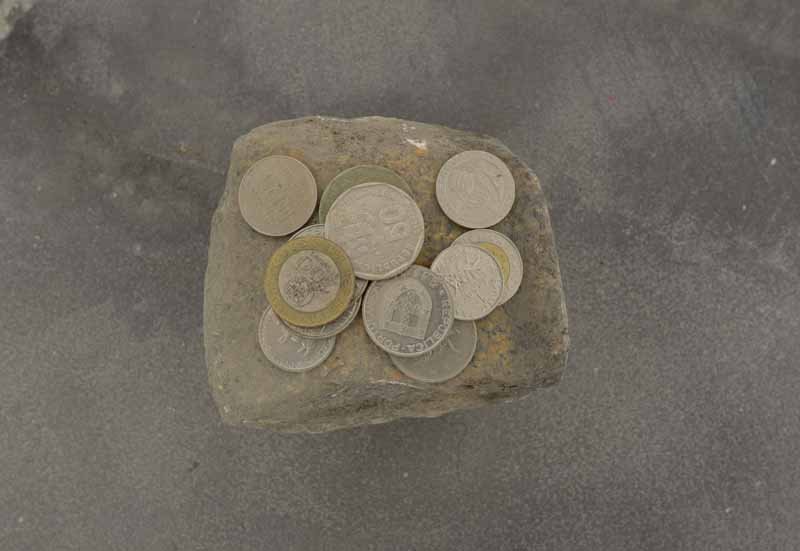

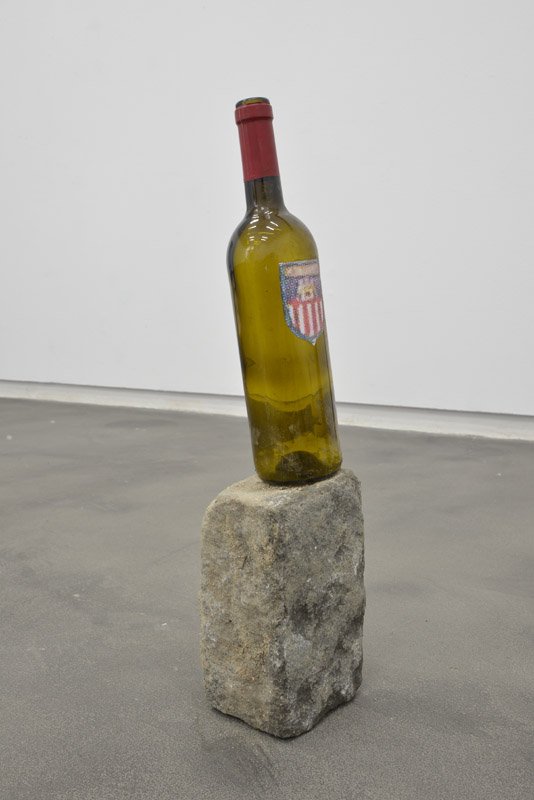
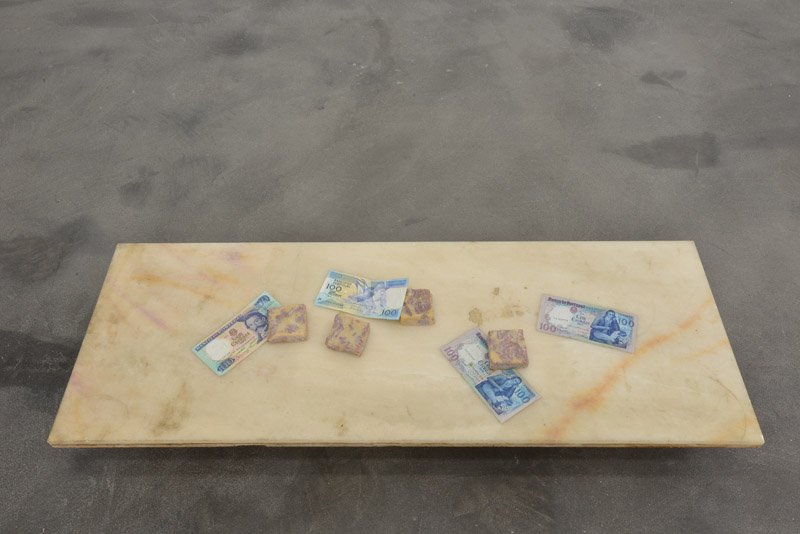

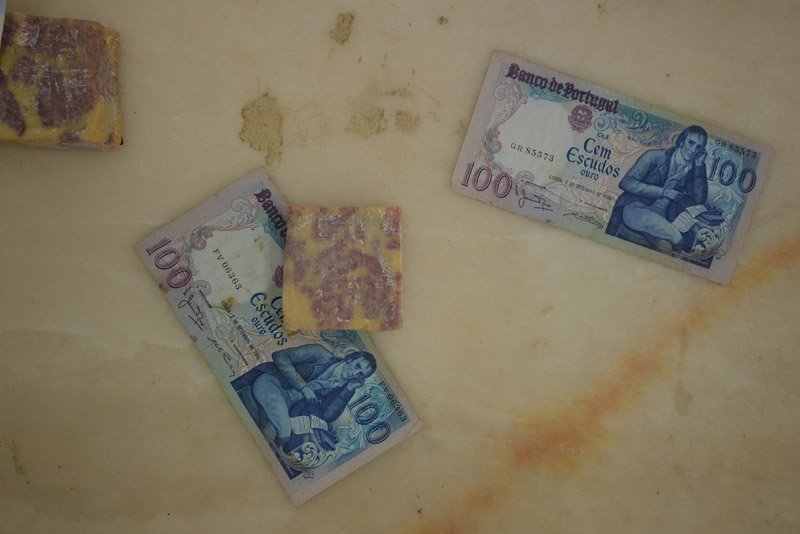
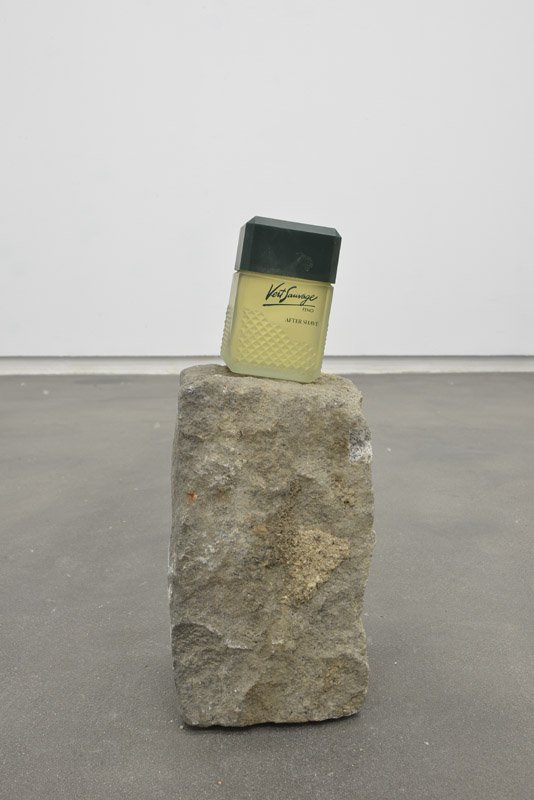
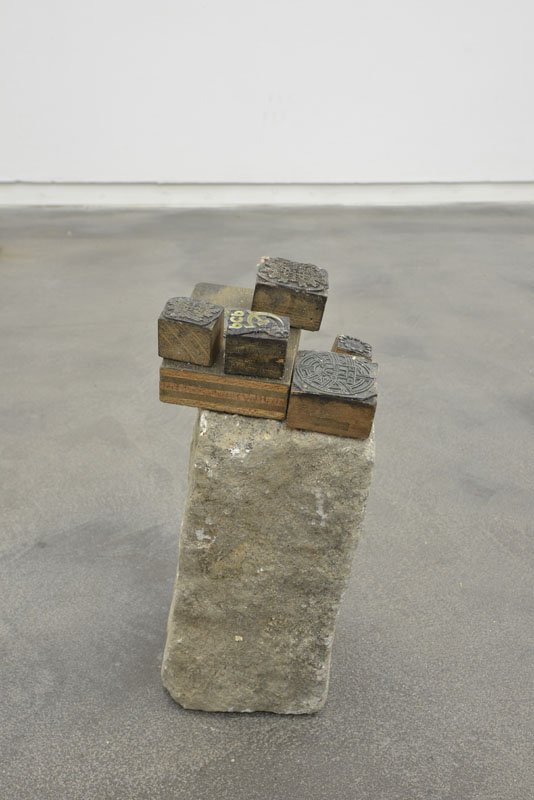
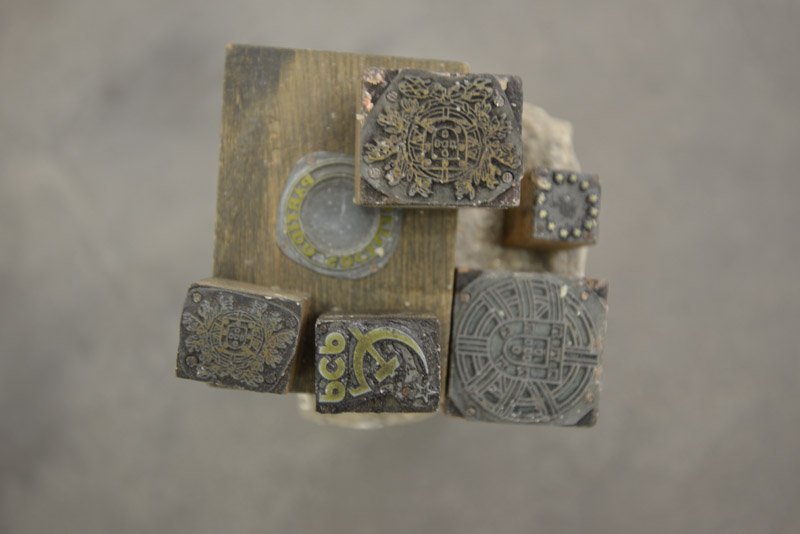

Galeria Heinrich Ehrhardt, Madrid, 2013
___________________________________________
The entranced gaze of the working class
Daniel Barroca, 2014
Ter que falar – Bêbado (Having to speak - Drunk):
A drunk man standing alone on a corner of Porto’s Baixa district. Building works have invaded the street, and the camera records a drunkard in a black beret, leaning against a wall, with a bag on the ground. After work, on his way home, late in the evening, loitering beneath the yellow light of the street lamps, in an empty dilapidated, unpaved street, fenced by iron railings affixed on concrete slabs, in the grips of gentrification, suspended in crisis, waiting. That corner will soon no longer be a suitable place for rambling drunks. The drunk is caught between the railing and the wall and, in that awkward position, begins to make his speech. He speaks into thin air as others walk by, people I’d call “non-drunks”. The drunk has decided to address the street, the public space, a space that seems to have fallen silent. The tone of his voice goes up and down, his arms gesticulate in indignation, as he articulates incomprehensible ideas for the “non-drunks”. He Protests. The drunk has adopted a radical, political position in his condition as an individual addressing the collective mass in the middle of the street! The collective mass circulates around him and he does what he can.
I increase the volume on my computer, as I listen attentively in order to be able to understand his protest and, as if it had nothing to do with me, I try to put myself in his head, to decipher the logic of his discourse, because I even believe that truth may well be channelled via altered states of soul. I’d also like to understand why Mauro Cerqueira decided to record this situation for about half an hour. It’s not clear what the drunk says and the camera records him in a succession of more or less fixed shots, which renovate the gaze of his comic figure, as he strives, with little success, to externalize an internal logic. He could even be an artist. The drunk’s discourse is, for the time being, incomprehensible to a non-drunk and it’s in this condition it fulfils its task. This is why it makes sense to compare him to an artist. He fulfils his task of articulating and updating the unfathomable, difference, that which has no translation. The drunk incomprehensibly expresses himself and it is in this incomprehensible dimension, as a spectator, that I try to align my life.
The camera:
The camera records him in a succession of more or less fixed shots, which renovate the gaze of his tragic-comic figure. Sometimes the camera hovers and we sense the operator’s hand movements and sometimes it’s fixed, apparently neutral. Its position defines the ideology of the image. The camera is sometimes participatory, as it interacts and dances with the object, feeding the event as in Baile do gatuno das cebolas (Dance of the Onion Thief) (for example). Sometimes it’s simply present, with a fixed gaze, allowing reality to unfold, and feeding off it, as in almost the entirety of Ter que Falar – Bêbado (Having to speak – Drunk) and Casa a Arder (House on Fire)..
In order to address the reality of the Rua dos Caldeireiros, Mauro sometimes engenders an indecisive amateurish aesthetic that has the cadence of the dialogue he establishes with the street’s residents. In other videos he draws close to the language of classical cinema. For example, when the camera rotates, in a perfectly synchronized movement, around Serafim 1 as if he were an actor placed in the frame 2. It's a camera that’s sometimes indecisive, and at other times precise, but never unconscious. Mauro is a member of the local community of the Rua dos Caldeireiros because he inhabits the street on a daily basis. Number 123 is his place of work. His work also takes place in that street, looking at it and producing things on the basis of its resources. He observes that reality from the inside and it’s from that perspective that he handles the camera. It isn’t the curious and superficial gaze of a tourist. This is an active gaze, that penetrates the complexity of the local context and circulates between its private spaces (Paulo’s house, Serafim’s shop and the corridor to the warehouse, China’s printing shop). This street is also the space of an old working class that lives, exchanges and shares things in the street. The street is a community space, of the group, completely different from the space of the middle class - which is the space of individualist isolation, created by blocks of flats. In a certain manner, and obviously with an element of romanticism, somewhere like the Rua dos Caldeireiros, one amongst many others, is the last stronghold of the collective community in our cities.
An Image is always a fictional construction because it forges a perspective that is filtered by technique. It is a fragmentation of that which is visible and everything that fragments the visible world, solely produces a version of the visible, and fictionalizes it. Mauro’s docu-fictions, produced in the Rua dos Caldeireiros in Porto, are 'fictions' that channel our gaze towards the depressed reality of that street. The daily lives of Serafim, Paulo, the Onion Thief and the Drunk correspond to the daily experience of the endangered existence of that community, which watches entranced as its territory is devoured by progress that destroys its social balance, which imposes gentrification of the city centre via an urban renewal programme that will expel the community from its traditional habitat.
Europe
In the Image of the drunk, as he gestures solitarily in confusion, as if embracing the imperative task of discovering a word that could mobilize the present and transform the world, I suddenly saw Europe.
In my room in Beirut, on my computer screen, I saw, and see, the capitulation of Europe. Europe that has been invaded by the markets and by the troikas. Portugal under technocratic occupation. A God-like, invisible and omnipresent force that shape our lives. And while we attempt to formulate a comprehensive discourse in relation to this invasion, this process of violent occupation, that involves no firearms, that which we want to fight, progressively consolidates itself.
We re-read the old revolutionaries and read the new ones, Marx, Ché, Cabral, Chomsky, Zizek, The Invisible Committee! We try to instruct ourselves against an enemy who understands much better than we do what we actually want, because it circulates in our blood and shapes our desires. At the same time as we seek ways to combat it, without thinking, with simple everyday gestures, such as turning on the television, going to the supermarket, surfing the Internet, we’re actually its collaborators. We’re simply unable to stop replicating it at our micro scale and disembodying it. It has the ability to anticipate our movements and absorb our gestures of resistance and transform them into the catalysts for its own development. The logic that a system always provides the tools for its own destruction seems to have been reversed. The machine that invades us, coming from all sides, from within and without, is far more effective than our ability to resist it. Resistance needs time to build up, it needs to reconquer the mind and body.
What the drunk in Mauro’s video tells me is that perhaps it isn’t the discourse that will lead us to effective tools of resistance - that perhaps discourse isn’t the path to liberation. Discourse will come later, the discourse about the revolution will come later because, if and when the revolution happens it will be uncontrollable and discourse always follows, discourse about the revolution occurs in the decadence of the revolution. And being European / Portuguese now means being trapped in a discursive loop, in which we’re unable to figure out how to channel this need for transformation. We’ve become the hostages of an exhausted vocabulary that just can’t stop repeating and emptying itself, like a doll. It means having neither the vision nor the ability to reinvent this vocabulary.
In Europe we’re waiting for a vision, caught between the dilemma of historical nations and economic union, in which the euro acts as a shredder and the colonial legacy continues to destroy the world 1. One hundred and fifty thousand casualties in Syria, in a conflict which is incomprehensible for Europeans, which, according to Adam Curtis, and also in relation to the vast majority of conflicts in the Middle East, has been transformed by Western media into a simplistic narrative conflict between vigilantes and villains. The Russian army marches into the Crimea. Hungary approves racist laws. Neo-Nazis utter anti-Semitic diatribes in Paris. Portuguese people once again learn what it is to be hungry and withdraw, once again emigrating en masse to the New World and exonerate the latent imagery of the old empire, when the shock waves from the death of that past still pulsates and its mourning is still far from over. Class differences are once again on the rise. The working class has been dismantled and therefore doesn’t have a cohesive body or a voice that can be heard. And yet, in the space that remains, there are those who gesticulate absurdly, while others simply pass by, on their way home, where they will sit staring at the TV news bulletin.
The long shot of Casa a Arder (House on Fire) in which the camera statically observes Paulo in his front room, rapt in front of the TV set. It's like a mirror that reflects an entire misaligned reality of his problem, as he waits for a vision that will break the spell that continues to petrify him.
------ Português ------
O olhar absorto da classe trabalhadora
Daniel Barroca, 2014
Ter que falar – Bêbado:
Um homem bêbado sozinho numa esquina da baixa do Porto. A rua está em obras e o que a câmara de vídeo regista é um bêbado com um boné preto encostado à parede com uma sacola no chão. Depois do trabalho, no caminho para casa, já de noite debaixo da luz amarela dos candeeiros públicos, numa rua destruída, vedada por grades de ferro assentes em sapatas de betão, sem pavimento, sem circulação, em processo de gentrificação, suspensa, em crise, à espera. Em breve aquela esquina já não será lugar para bêbados que discursam. O bêbado ficou entalado entre a vedação e a parede e foi nessa posição que se pôs a fazer o seu discurso. Fala para o ar enquanto os outros passam, pessoas a que eu chamarei de não bêbados. O bêbado tomou uma atitude que foi a de falar na rua, no espaço público, que é um espaço que parece ter ficado mudo. O seu tom de voz sobe e desce, os braços gesticulam de indignação, articulando o incompreensível para os não bêbados, ele Protesta. O bêbado tomou uma posição política, radical, que é a de na sua condição de individuo falar para o colectivo no meio da rua! O colectivo circula em dispersão e ele faz o que pode.
Subo o volume do meu computador, abro os ouvidos para conseguir entender o protesto e como se não tivesse nada a ver comigo tento colocar-me na sua cabeça para entrar na lógica do seu discurso porque até acredito que a verdade pode muito bem ser canalizada por estados alterados da alma e porque me interessa compreender porque é que o Mauro Cerqueira gravou esta situação durante aproximadamente meia hora. Não se percebe o que diz e a câmara enquadra-o numa sucessão de planos, mais ou menos fixos, que vão renovando o olhar sobre a sua figura cómica e empenhada em, sem grande sucesso, exteriorizar uma lógica interna. Podia até ser um artista. O discurso do bêbado é, por enquanto, incompreensível para um não bêbado e é nessa condição que cumpre a sua tarefa. É este o sentido da comparação com o artista. Ele cumpre a sua tarefa de articular e atualizar o irreconhecível, a diferença, o que não tem tradução. O bêbado manifesta-se incompreensivelmente e é esse incompreensível que como espetador eu tento alinhar na minha vida.
A câmara:
A câmara:
A câmara enquadra-o numa sucessão de planos, mais ou menos fixos, que vão renovando o olhar sobre a sua figura cómica. Por vezes oscila e sente-se a mão do operador, por vezes está fixa, aparentemente neutra. O seu posicionamento define a ideologia da imagem. É uma câmara às vezes participativa, que interage e dança com o objecto alimentando o acontecimento como no Baile do gatuno das cebolas (por ex.); por vezes apenas presente, que olha fixa, deixando o real acontecer, alimentando-se dele, como em quase todo o Ter que Falar – Bêbado e Casa a Arder.
Para se referir à realidade da Rua dos Caldeireiros o Mauro, por vezes, engendra uma estética amadora indecisa que tem a cadência do diálogo que ele estabelece com os seus habitantes, por outras, aproxima-se da linguagem do cinema clássico. Por exemplo, quando a câmara roda num movimento perfeitamente sincronizado com o Serafim1 como se este fosse um ator que é colocado em campo2. É uma câmara ora indecisa ora precisa mas nunca inconsciente. O Mauro faz parte da comunidade da Rua dos Caldeireiros porque ele habita aquela rua diariamente, o número 123 é onde trabalha e o seu trabalho é estar naquela rua, olhar para ela e produzir a partir dos seu recursos. Ele olha aquela realidade a partir de dentro e é daí que ele manuseia a câmara. Não é o olhar curioso e superficial do turista. É um olhar presente, que se insere profundamente na complexidade do contexto e que entra e sai dos seus espaços privados (a casa do Paulo, a loja do Serafim e o corredor para o armazém, a tipografia do China). Esta rua é ainda o espaço de uma velha classe trabalhadora que vive, troca e partilha na rua. A rua é o espaço da comunidade, do colectivo, completamente diferente do espaço da classe média que é o espaço do isolamento individualista dos blocos de apartamentos. De algum modo, e obviamente com algum romantismo, um lugar como a Rua dos Caldeireiros, um entre tantos outros, representa o último reduto do colectivo nas nossas cidades.
A imagem é uma ficção porque é sempre uma construção do olhar filtrado pela técnica. É uma fragmentação do visível e tudo o que é fragmentar o visível é produzir uma versão do visível, é ficcioná-lo. As docuficções que o Mauro faz na Rua dos Caldeireiros no Porto são ‘ficções’ que canalizam o nosso olhar sobre a realidade deprimida dessa rua. O quotidiano do Serafim, do Paulo, do Ladrão das Cebolas e do Bêbado é o quotidiano da vida em extinção daquela comunidade que assiste absorta ao cilindrar do seu território por um progresso que destrói o estado social, que impõe a gentrificação do centro da cidade através de um programa de recuperação urbano que a vai expulsar do lugar que sempre habitou.
A Europa
Na imagem do bêbado, sozinho a gesticular confusão como se estivesse a abraçar a tarefa imperativa de fornecer a palavra que poderia mobilizar o presente e transformar o mundo, vi de repente a Europa.
No meu quarto em Beirute, no écran do meu computador, vi e vejo a Europa capitular. A Europa que foi invadida pelos mercados e pelas troikas. Portugal sob ocupação tecnocrática. Forças invisíveis e omnipresentes como deus que nos formatam a vida. E enquanto procuramos formular um discurso compreensível sobre essa invasão, sobre esse processo de ocupação violento mas sem armas de fogo, aquilo que queremos combater, consolida-se.
Relemos os velhos revolucionários e lemos os novos, Marx, Che, Cabral, Chomsky, Zizek, O Comité Invisível! Instruímo-nos contra um inimigo que sabe sempre muito melhor do que nós o que queremos porque circula no nosso sangue e modela o nosso desejo. Ao mesmo tempo que procuramos vias para o combater, sem pensar, com os gestos simples do quotidiano como ligar a televisão, ir ao supermercado, navegar na internet, somos seus colaboradores. Simplesmente somos incapazes de deixar de o replicar à nossa micro escala e de o desincorporar. Ele tem a capacidade de antecipar os nossos movimentos e de absorver os nossos gestos de resistência e de os transformar em alavancas para o seu próprio desenvolvimento. A lógica de que um sistema fornece sempre os instrumentos para a sua própria destruição parece ter sido invertida. A máquina que nos invade, que vem de todos os lados de fora e de dentro, é muito mais eficaz do que a nossa capacidade de lhe resistir. A resistência precisa de tempo para se constituir, precisa de reconquistar a mente e o corpo.
O que o bêbado no vídeo do Mauro me diz é que talvez não seja o discurso que nos levará aos instrumentos efetivos da resistência, que talvez o discurso não seja a via para a libertação, o discurso virá depois, o discurso sobre a revolução virá depois porque, se, e quando acontecer será incontrolável e o discurso vem sempre a seguir, o discurso sobre a revolução acontece na decadência da revolução. E ser europeu/português agora é estar preso num loop discursivo sem conseguir vislumbrar um modo de canalizar essa necessidade de transformação. É ter ficado refém de um vocabulário exausto que simplesmente não consigo parar de repetir e esvaziar como um boneco. É não ter visão nem capacidade de reinventar esse vocabulário.
Na Europa estamos à espera da visão, entalados entre o dilema das nações históricas e da união económica, o euro é uma trituradora, a herança colonial ainda destrói o mundo1. Uma centena e meia de milhares de mortos na Síria, num conflito incompreensível para um europeu, que segundo Adam Curtis, e em relação à generalidade dos conflitos no médio oriente, foi transformado pelos media ocidentais numa narrativa simplista entre justiceiros e vilões. O exército Russo marcha sobre a Crimeia. A Hungria aprova leis racistas. Neonazis gritam palavras de ordem anti-semitas em Paris. Os portugueses voltam a saber o que é a fome e encolhem-se, voltam massivamente ao novo mundo e exoneram o imaginário latente do velho império quando o choque pela morte desse passado ainda pulsa e o seu luto está longe de ter terminado. As diferenças de classe voltam a acentuar-se. A classe trabalhadora foi desmantelada e por isso não tem um corpo coeso nem uma voz que se ouça. E entretanto, no espaço que resta, há os que gesticulam absurdamente enquanto outros simplesmente passam no caminho para casa onde vão ficar, de olhar absorto, em frente ao telejornal.
O longo plano do Casa a Arder em que a câmara fica estática a olhar para o Paulo, absorto em frente à televisão da sala, é como um espelho que reflete toda uma realidade desalinhada do seu problema à espera da visão que venha quebrar o feitiço que ainda a petrifica.
Acknowledgements | Agradecimentos:
Mauro Cerqueira, Maria do Carmo Piçarra
The text for this article was enriched by my discussion with | A escrita deste artigo foi alimentada pelos meus diálogos com:
Roger Outa, Christabelle Peters, Catarina Laranjeiro, Eduardo Petersen, Rachel Levine, Mohamed Berro, Philip Pilekjær, Alicja Rogalska.Translation: Martin Dale